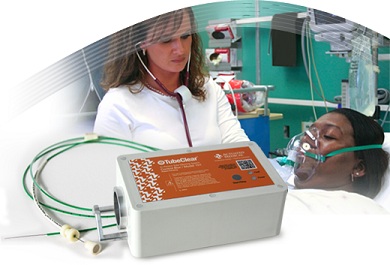About 25% of NG tubes used for feeding, medication delivery, or release of stomach gas get clogged from food and medicine residue. When this happens, it interferes with the tube's function as well as taking health care personnel away from their jobs. Until now, tubes were cleaned with an enzyme treatment or a combination of warm water and cola, both of which took anywhere from thirty to almost ninety minutes to completely dissolve a clog.
In August 2012, a new, much quicker alternative came on the market: TubeClear was granted FDA approval. In tests using tubes and a mixture of the feeding formula with fiber similar to the ones used for patients, it showed that it can unclog a tube in three minutes or less, saving time for medical personnel and sparing the patient the discomfort of the methods involving cola or enzymes to dissolve a clog, or even replacement of the tube.
The main components of the system are a single-use clearing stem and a control box. After removal from the packaging material, one end of the clearing stem is attached to a wire which is connected to the control box. The control box feeds the clearing stem into the tube and moves it forward and backwards. The clinician performing the procedure loosely coils the wire and holds it in one hand to control it. After the clearing stem is fed into the NG tube, it pushes against the clog until it reaches the end inside the stomach. Using smaller back-and-forth movements, the tube is cleared of any remaining residue. When the tube is unclogged, the clinician uses the control box to pull the clearing stem out. The clearing stem and any residue clinging to it is placed back in the package, and then disposed of in accordance with the health care center's policy on bodily waste. In just minutes, the nutrition and medication regimens can be reestablished and the clinician is able to return to duties instead of dealing with hardware issues.

In addition to saving time, TubeClear helps to control costs and in many cases, prevents the need for tube replacement.
Two other models have also been developed. One for NG tubes that can be configured to run on either AC or battery power, and one that can be used to clear PEG tubes with matching clearing stems are awaiting FDA approval. All three models of TubeClear are now available internationally. It is suitable for use in hospitals and nursing homes.
In January 2012, the TubeClear made its debut at the ASPEN Clinical Nutrition week. Its demonstrations met with positive reviews by two hundred clinicians. It was demonstrated in May at the Teaching Institute and Critical Care Exposition in Orlando, Florida. Currently, enrollment for a study of its safety and efficacy is under way at Walter Reed National Military Medical Center.
Fran Jablway
and
Hulet Smith, OT